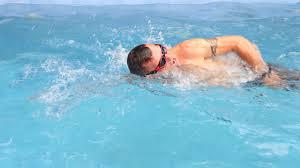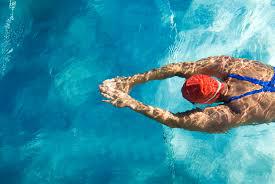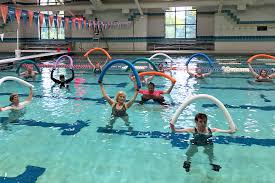Swimming’s popularity is on the rise, as aging baby boomers look to maintain their fitness, without the pain and risk of injury that accompany sports like running, cycling, and tennis. Water is 700 times denser than air, making swimming a cardiovascular and a strength workout and one of the best anti-aging exercises. Older swimmers claim it is the “fountain of youth” allowing them to stay strong and active when compared to non-swimmers. An Indiana University study came to that same conclusion.
Take the plunge and enjoy the incredible health benefits of this full body workout!
The Best Anti-Aging Exercises
 increased cardiovascular strength and endurance
increased cardiovascular strength and endurance- increased respiratory function
- resistance training for your arms, shoulders, back, glutes, and legs
- improved core strength with each kick, rotation, and stroke
- enhanced flexibility and improved range of motion
- potential to improve health markers including blood pressure, cholesterol levels, and blood chemistry
- calorie burn in the 400-600 calories an hour range, which compares to running
- therapeutic effects of hydrostatic pressure and cool water which promote blood flow, remove waste products and enhance the healing of injuries
- long, strong musculature, making for a desirable body shape
- improved cognitive function as your brain works to coordinate the technical aspects of each stroke
Swimming is the perfect exercise for those suffering from joint pain or disease, working your cardiovascular and respiratory systems without taxing the body like weight bearing exercise. For overweight or obese individuals, swimming is the best option for exercise and to encourage weight loss. Swimming also protects against heat related illness for those in hot climates or the very overweight.
According to an international study, swimming is also a powerful tool to fight stress and depression, allowing for a more complete break from the real world. Swimming offers similar benefits as meditation. Being in water is “fun” and allows you to move your body like you did when you were a kid.
U.S. Master’s Swimming boasts over 60,000 members, with 1500 clubs in the US, and growing. Master’s swimmers are all ages from 18-100. Many learned to swim as adults. Learning to swim is a great investment, as you can swim for a lifetime. Swim lessons teach the basics of proper stroke mechanics. All swimmers should work to continually improve technique to swim more efficiently.. Keep in mind, the better your stroke, the more you will enjoy swimming!
Swimmers use a variety a gear to enhance technique, build strength, and, if desired, make swimming easier:
 chlorine resistant swimsuit
chlorine resistant swimsuit- silicon swim cap
- goggles
- kickboard
- fins
- paddles
- pull buoy
- snorkel
Mix up the type of swim workouts you do each week-some longer and some faster and shorter. Use the kickboard to work on strengthening your legs. Use a pull buoy and paddles to concentrate on the pull. Try a snorkel to take the breathing out of the equation. Fins can help teach proper body position, strengthen your legs and core, and help you feel how you should be swimming.
Warm-up
Gently warm your large muscles groups before you swim with some dynamic yoga poses and easy arm circles to get your shoulders warm. Start your swim with a slow 100-200 yards freestyle (one length is 25 yards, so 100 is 4 lengths).
Workout Sets
- Kick with a kickboard. Kick 6x 25s on with 20 seconds rest between each, concentrate on kicking from the core, with little knee bend.
- Move to drills to improve your stroke. Swim freestyle with hands closed in fists for one 25 and then regular swim on the way back (this drill makes you use your whole arm to pull and makes you appreciate your hands). 3×50 drill down, swim back
- Fingertip drag drill-drag just the tips of your fingers across the top of the water (this drill forces you to have high elbows and reach your fingers far out in front of you, without crossing that midline). 3×50 drill down, swim back
- Mix in other strokes-backstroke, breastroke and even learn to swim butterfly. 6×25 stroke
- Try sets of 25s, 50s and 100s depending on your skill in the water. Give yourself 10-30 seconds rest between intervals.
- Do a longer swim of 200-500 yards (8-20 lengths).
Check out these resources for more information on swimming
If swimming is not your thing, you can still get the benefits of exercising in water. Try a water aerobics class, or walk or run in the water. Check out the options at your local YMCA or recreational center. Pools are busy all day long, as swimming and water exercise continue to grow in popularity. Many pools require reservations, at this point in time, so you can be assured your own space.
Take the plunge, and enjoy all the benefits of moving in the water.

by Christy Coughlin
